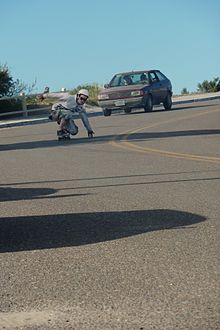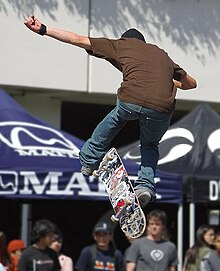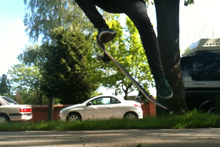Skateboard trick
A skateboard trick is a special maneuver performed with a skateboard .
Classification
Skateboard tricks are roughly divided into the following categories:
- Grabs: Tricks in which you grab the board with your hand and pull it to the side, forwards or backwards
- Flips: Tricks in which the board rotates around its own axis, mostly between or under the rider's legs. They are initiated by pulling the foot over the top of the board or by pushing down. After the rotation movement, the board is stopped with the forefoot, the landing is initiated by placing the legs correctly over the board. When landing on the ground / the ramp, the legs must not be bent in order to cushion the remaining energy and to protect the joints.
- Grinds: Tricks that are performed with the help of a curb or a pipe (coping / rail). Grinding takes place on the trucks and sliding on the deck.
- Flatlands: Tricks that you perform on the ground and usually don't jump through a kicker or other ramps, but rather with a so-called ollie (a jump from a standing position)
- All tricks (grab, flip, grind and flat) can be performed in a combination with so-called spins. They are rotations around your own body axis. They are named in degrees (180 ° steps). A distinction is made between front side (fs) and back side (bs). A spin that bs is performed is performed to the back side. The head initiates the rotation.
Origin of the disciplines
Street skating
In street skating , the tricks are carried out on obstacles such as walls, stairs, railings, ramps and the like or in a specially created obstacle landscape ( skate park ). In pure street skating outside of skate parks, property damage and noise occasionally lead to conflicts with residents, house and property owners. A terrain suitable for street skating is called a spot . The American professional skater Rodney Mullen is considered to be the originator of street skating , numerous tricks and techniques go back to him.
Vert
In addition to the streetskating is vert skating (from English vertical for German perpendicular ) is of importance. Here the skateboard is driven in a specially created halfpipe , a U-shaped system in which the skater drives on two opposite, in the upper part vertical steep walls ( vert ), which are rounded off ( transitions ) with a horizontal plane in between ( flat ) are connected. In vertskating, the tricks are performed either as flight tricks ( airs ) above the steep face or on the edge of the steep face, which is usually provided with a steel tube ( coping ) ( liptricks ).
A popular modification of the halfpipe is the mini ramp , a lower construction without the vertical part of the steep wall. The roots of skateboarding can be found in the shape of the halfpipe and mini ramp: The curves and some of the resulting movements are reminiscent of surfing . The skateboard lip tricks have shaped the surfing style of the last decades ( new school ). Occasionally, so-called fullpipes are used (tubes with a large diameter, in which you can get good momentum by driving back and forth).
Others

So-called bowl or pool skating has established itself as a further independent discipline . This form of skating has its origin in drained swimming pools in the USA. In contrast to the construction of European swimming pools, American pools with round or kidney-shaped floor plans often have rounded transitions from the pool wall to the pool floor or are even constructed in the shape of a bowl. This specific construction enables the pools to be driven on. Due to the similar shape of the pool or bowl, skating is related in some respects to vertical or mini-ramp skating. In the past few years such American pools have been rebuilt in an optimized form in some skateparks.
Flatland, slalom and downhill skating are of lesser importance than street and vertical skating. In flatland skating , which was particularly popular in the 1980s, there are largely no obstacles involved. The tricks are performed here with an artistic focus and with the emphasis on the skateboard as a kind of gymnastics device, predominantly on a flat surface. The slalom board , which was particularly popular in the 1970s, is about driving through a slalom course quickly and without errors. Downhill skating is mostly done with a longboard and designed at top speed on a downhill stretch.
Basic tricks
Ollie
Basic trick of modern skateboarding is the Ollie . This trick is a technique with which, through temporal and motor coordination, you can jump from an impulsive kick that lets the board shoot up onto the rear overhang (tail) and leading movement of the front foot over the grip tape with the skateboard. Although the skateboard is not connected to the skater, the deck can be controlled and steered by this technique in the flight phase of the jump. This allows even rotations to be carried out, such as. B. the FS 180 °.
The Ollie was first invented and used by Alan “Ollie” Gelfand in the halfpipe as a so-called “no hand air” - a jump in the air in the halfpipe, whereby the deck was not fixed with one hand under the feet. Rodney Mullen later transferred the ollie to flat terrain and street skating, known as the pop ollie, because popping (= jerking the tail) allows you to jump on flat streets. When one speaks of an ollie today, it usually means the ollie Rodney Mullens. The additions "Flat Ollie" or "Pop Ollie" are very rare.
Flips and shove-its
The naming of the skateboard tricks in contemporary skating is usually determined by the jumping and flight movements performed with the skateboard, for which mostly rotations of the deck around the longitudinal axis - flip tricks - or around the vertical central axis - shove-its - and also a combination of both belong. The name is also derived from the rider's movements in relation to his board, from the rider's position in relation to the jumped obstacle and from the movements on the obstacle itself.
Slides and grinds
The part of the skateboard with which an obstacle is jumped is important: If the skater slides the deck over an object, this is called a slide, such as tricks such as boardslide, lipslide, nose slide and tailslide. There are also bluntslides and nose bluntslides where the skater either slides on the rollers of the front or rear axle. If, on the other hand, he slides with one or two axes on the edge of an object, one speaks of a grind such as the trick 5–0 grind involving the rear axis or 50–50 grind involving both axes.
Grab tricks
In a grab trick, the rider touches the skateboard with one or both hands during a jump (for example, a nose grab, where the tip of the board is touched).
Challenges
The great variety of modern skating is achieved through multiple combinations of different, individual tricks in one overall trick. It is also more difficult to perform a trick while, contrary to the individual and intuitively given foot position - either "regular" (that is, the left foot is in front of the board) or "goofy" (that is, with the right foot in front ) - it says on the board - switchstance or switch drives, nollie drives, i.e. for regular the left foot forwards and straight ahead or for goofy the same thing, only with the right foot forwards - or even drives backwards (that is a trick fakie do).
In addition to the increasingly difficult combinations of tricks, skating jumps are used to overcome ever greater heights and widths. Popular obstacles are steps or other obstacles ("gaps") and also grinds and slides on stair rails ( handrails ).
Explanation
- Street tricks are the tricks that (Engl. At an obstacle obstacle ) to run on the street or in a skate park and is required for any special ramp. The can of stairs ( stairs ), railings ( handrails ) or curbs ( curbs to be) and much more.
- Vert tricks are performed in a half pipe . A distinction is made between two categories. The lip tricks are tricks that are performed on the upper edge ( coping ) of the halfpipe. The other category are air tricks (of English. Air , air '), which are different handles ( grabs ) and tricks with the skateboard spins (called in the air flips are). It is also possible to slide along the half-pipe on the coping (so-called sliding or grinding ), as is also done with street skating. In addition to half pipes, smaller structures such as mini ramps and quarter pipes are also used, which are also suitable for beginners.
- Flatland or freestyle tricks are done on the ground. This includes turning the skateboard as well as so-called old - school tricks in which the foot is allowed to touch the ground. Freestyling is mainly about more acrobatic inserts, such as a handstand on the skateboard, flowing footwork tricks or balancing on the tail on the axes of the upside down board ( 50/50 tricks ). Freestyle tricks have continued to evolve throughout the history of skateboarding. Many of the tricks that would fall into the street category these days came from freestyle. A trick can therefore also belong to several categories.
- The execution of a trick in the course of which exactly one foot touches the ground is called Boneless , Fastplant , Sweeper or No Comply , depending on which foot you step off with or whether you touch the board with your hand. If both feet touch the ground, this is called a sweet .
Trick list (selection)
All tricks can be combined in any way, so the list does not claim to be complete.
- Ollie - The rear (preferably the stronger) foot is placed at the end of the board, the other in the front part of the board. The board is quickly tilted over the rear axle by shifting your weight on the rear foot so that it touches the ground (so-called popping). At the same time, the front foot pulls forward on the "nose" and pulls the board up. Thus no role touches the ground anymore. The ollie or ollie variations are at the beginning of many tricks.
- FS / BS - Every grind / slide or rotation can be done “frontside” or “backside”. These terms originally come from surfing and indicate the direction from which you are approaching the wave (or the obstacle). If you look at the obstacle, it's a frontside trick. If the obstacle is to your back, it's a backside trick. It looks different when the body rotates. A 180 ollie is called frontside if after 90 degrees the face points in the direction of travel, backside if after 90 degrees the back points in the direction of travel. A simple trick to remember for all driving styles, i.e. Regular, Nollie, Fakie, Switch, is that Regular drivers turn clockwise backside, Goofy drivers turn frontside and vice versa.
- Alley-Oop or Aliub - A trick is Alley-Oop when the direction of rotation is opposite to the direction of jump / approach. Example: The skater drives up a halfpipe frontside, but then turns backside. These tricks are usually particularly difficult to perform.
- Footwork - This includes "movements" with the board that are not really referred to as tricks. Footwork tricks are only used in freestyle or a freestyle run to fill in the “gaps” between the other tricks. They come from dance moves and mostly become a fluid and even movement.
- Grave - A grave refers to touching the skateboard with your hands.
- Tweak - A grave, or some other trick that is particularly warped and where the legs are very straight. The skater should be in the air for a long time to optimally tweak a trick. Requires tremendous acrobatic fitness and body coordination.
- Popping - One speaks of popping or popping the board as soon as the "clacking" of the board is heard during a trick based on the ollie, or the ollie itself. A skater with more "pop" can jump higher on the skateboard.
- Spin - The horizontal turning of the board, mostly pop-shove-its.
- Catch - Landing your feet on the board after a flip / spin trick before hitting the ground. You can control the board better this way.
- Kickflip - The skater pulls the board up like an ollie and pulls the front foot off the board so that the board rotates 360 ° around the longitudinal axis towards the skater. As soon as the board has turned once and the skater lands again, the kickflip is complete. As soon as the board rotates a second time without pulling your foot again, the trick is called double kickflip, with three times triple kickflip and with four times quadruple kickflip etc.
- Heelflip - The heelflip is basically the same as the kickflip, only that it rotates in the opposite direction. The skater pulls the foot up like an ollie and pulls the front foot out at the nose at an angle. The heel turns the board in the desired direction. Once the board has turned around its longitudinal axis and the skater lands with both feet on the skateboard, the trick is counted as confessed.
- Manual - The skater pushes one side of the board down so the rollers on the opposite side rise into the air and the tail or nose does not touch the ground. Now the skater has to balance the board like this. This trick is mostly used as a "connection" between the tricks, this is called a "combo". You can hold the manual as long as you want and can.
- Pressure - Instead of flipping their front foot, the skater presses into the concave of the skateboard and does the tricks.
literature
- Steven Kane: Skateboard: full of tricks (translation into German: Joseph Zacharias). 1st edition, Pietsch, Stuttgart 1992, ISBN 3-613-50151-1 .
- Günter Mokulys and Thilo Nawrocky: Streetstyle-Skateboard-book. Part 1. 5th edition, Monster-Verlag und Promotion, Münster 1990, ISBN 3-927328-01-4 .





